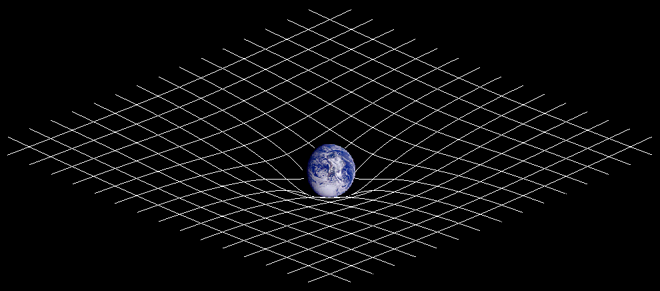
Nobel Prize Physics 2017 - Gravitational Waves
Klaas S. de Boer, Argelander Institut für Astronomie, Univ. Bonn
In the autumn of 2015, the first detection of gravitational waves was a fact. The scientists of the Laser Interferometer Gravitational-Wave Observatory (LIGO) took several months, to February 2016, before announcing this feat. They wanted to be very sure all was in order.
To understand how gravitational waves have been detected
one has to explain some background facts.
These topics include:
1. gravity, space-time, potential well,
2. basics of stellar evolution, especially of binary stars,
and
3. emergence of gravitational waves.
1. Gravity, space-time, potential well
Gravitational waves are old. First, because the waves detected come from far away objects in the Universe, so the waves must have travelled a long time before they could reach Earth. This will be explained later. Second, the concept of gravitational waves comes from Einstein and is thus 100 years old. He combined, in 1916, his relativity theory of 1914 with an idea of Schwarzschild of 1916. Schwarzschild had considered how the gravitational field around a point mass (an extremely compact star) would look like if one included Einstein's relativity theory. Schwarzschild concluded that if the surface of a star (or any object) had extremely strong gravity, light from that surface would be unable to escape from that star. Such an object would for us be invisible. In fact, it would be a blak spot in the sky because also light from its surroundings would be sucked in by that gravitational field.
When Einstein developed his general theory of relativity, he found a new way to describe gravity. He noted it was not a force, as Sir Isaac Newton had proposed, but gravity is a consequence of a distortion of space and time, space and time are intimately connected as "space-time". Objects distort the fabric of space-time based on their mass where more massive objects have a larger effect.
If an object distorts space-time, then how should we visualise that?

|
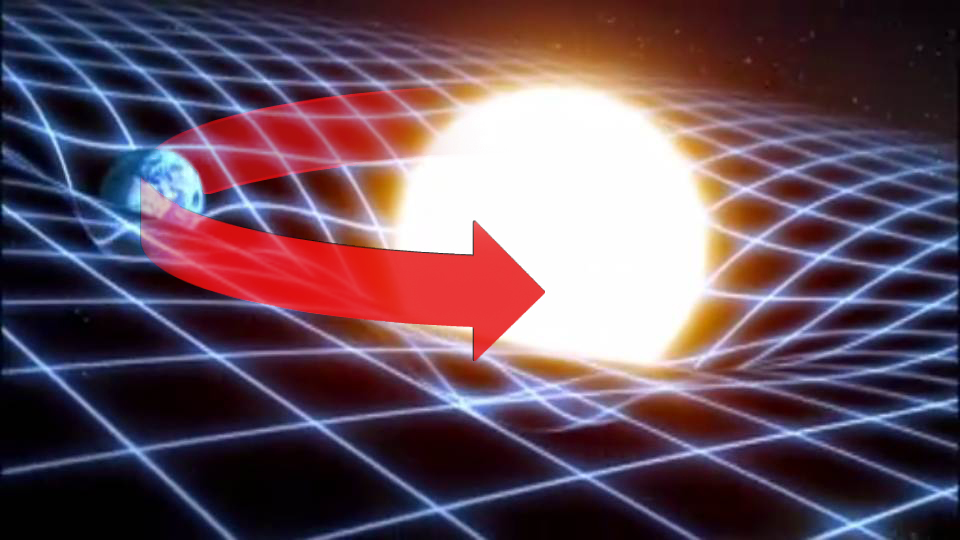
|
As we all know, if a marble is aimed to go into the well while its speed is sufficiently large, it will dive in but leave the well again, by then in a direction different from the original one. If one sets a marble rotating inside the well, it will just continue to go around. In 3-dimensional space this works the same. The image (not to scale) shows how one can imagine that the Earth orbits around the Sun because it moves inside the potential well of the Sun. And of course, Earth has its own (small) potential well in which the Moon orbits!
Now Einstein made a bold prediction. He claimed that light does not go in straight lines due to gravitational forces.... if one thinks in the “classical” way. Seen in relativity theory, light goes straight but space-time is curved. If one were to look, classically, immediately past the edge of the Sun, one would have to note that stars do not show up in their "normal" position. This was confirmed during a Solar eclipse and so Einstein became famous, also with the public.
This all led to the following idea. Since a very, very large mass object has a very, very deep potential well (the well looks like a hole) such that light cannot escape and be detected by us, this object therefore seems black. Such an object was called a Black Hole. This name was actually given much later, by Wheeler in the 1940s, but caught on immediately.
|
A black hole is an object in a very deep gravitational potential well |
2. Basics of Stellar Evolution
Stars come in different sizes and emit different amounts of light.
They evolve according to their initial mass.
Five very simplified examples:
1. Very low mass stars stay rather dull and toward the end
of their life they just peter out.
2. Stars of low mass (like the Sun)
evolve to a late bright and brief expanded phase
in which they blow off their outer layers,
then shrink and end as compact "White Dwarfs".
3. Stars of the middle mass range become bright toward the end of their
life, blow off part of the outer layers and eventually explode,
they become "Supernova".
A compact and very dense "Neutron Star" remains.
4. Very high-mass stars evolve fast.
When they explode and become supernova,
they leave a very compact and heavy "Neutron Star" that,
if massive enough, would be a black hole.
5. Finally, many stars come in pairs that orbit around each other,
in their overlapping potential wells.
These stars are important for the gravitational wave story.
|
|
|
Binary stars orbit around each other, in a joint potential well (figure; de Boer+ 2008). If they are rather close to each other, the overlap of the potential wells will deeply affect the evolution. As one of the stars expands and starts blowing off the outer shell, a good portion of that material (if not all of it) flows over the saddle between the two potential wells and is assembled by the companion star, making that star more massive. Depending on the initial mass of the stars in the pair this may lead, in the course of evolution, to a to-and-fro of mass exchange. Each time a star collects mass, its evolution will become different, which makes modelling of such systems a large undertaking. Two examples of binary stellar evolution are given (figure below).
There is clearly a huge variety of binary-star systems. The stars can have a range of initial masses and their initial separation can be quite different. It should be clear, that the closer systems will interact much more. If the two stars both have rather large initial mass, then such a system may, after its evolution with ample mass exchange, become a system consisting of at least one black hole, perahps even two, as in the example of Marchant et al. (2016).
|
|
|
One further aspect of the evolution of binary stars is important. The stars orbit each other and exert a gravitational force on each others gases. This causes friction, that is lost as heat. So the system looses energy. The energy lost is compensated for by making the separation of the stars smaller. A binary-star system thus becomes, with time, ever tighter, the two stars spiral in. On the other hand, if the overall system ejects mass by, e.g., polar mass jets in "Gamma Ray Burtsters" (GRBs; see right panel in figure above), the mass of the stars and their mutual gravitational pull becomes smaller and so the orbits will become wider, the orbital period larger.
3. Making gravitational waves
All waves propagate. If one throws a stone in a pond, a wave is produced at the point of impact and this wave propagates radially outward eventually becoming just a
|
|
An object moving on the water produces similar waves,
except that the wave is higher in the direction of motion and the
distance between the waves is shorter there (than in the other direction).
When two objects move around each other, a complicated wave pattern
emerges from the overlap of the individual wave patterns.
And when the objects move faster, the waves get higher and the
distance between the waves is shorter and the pattern will look very agitated.
Take the gravitational well pattern above, and imagine it is rotating. This will generate waves in the space-time fabric. Two black holes in orbit around each other do just that.
|
|
|
Exactly this was Einstein's idea. The gravitational waves generated by orbiting black holes will propagate outward, the wave peaks of course becoming lower with distance travelled. When indeed the orbital separation becomes smaller (because of the friction exerted by and on each) then the period of the orbit becomes smaller, the wave rhythm faster, the speed of the objects becomes larger, they spiral in, the wave generated becomes stronger.....
4. Detecting gravitational waves
Scientists have considered off and on if gravitational waves could be detected. The effects on local space-time would be minute. Once optical lasers became established it was clear these light sources would be needed in an interferometric mode to detect any signal at all.
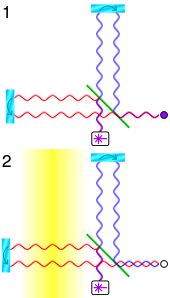
|
Principle of the LIGO interferometer. |
Early experiments started in the 1970s at MIT. Soon also other groups built prototype gravitational wave interferometers, among them GEO600 near Hannover (Germany). Ultimately, numerous groups participated in the Laser Interferometer Gravitational-Wave Observatory (LIGO) project. The LIGO lasers were built by GEO600.
The principles of the LIGO interferometer are explained with the figure. All elements of the interferometer have to be positioned with utmost care. Disturbances of any kind (earthquakes, storms, local traffic,....) can mess up a stable interference pattern. Moreover, the light path from laser to mirror should be very long to make a gravitational wave detectable at all. For these reasons the light beams run through some 4 kilometer long closed tubes in deserted parts of the USA. Getting a stable situation in such long tubes at the same time....
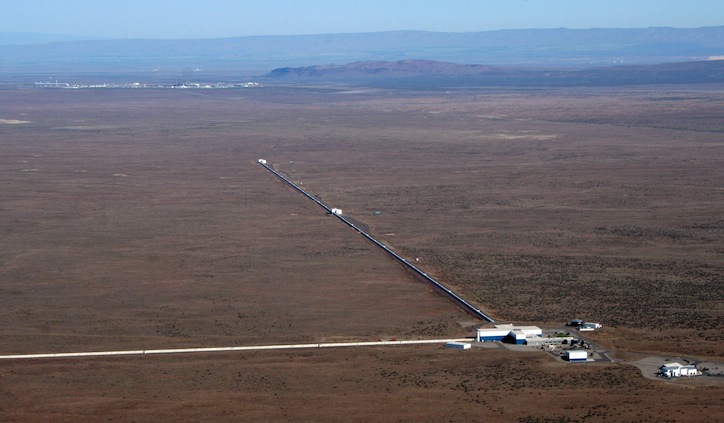
|
|
|
The LIGO station at Hanford Reservation, Washington State, USA. Each tube protecting the path of the laser beam is 4 km long. At right the northern leg. Images from LIGO. | |
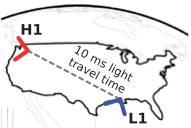
|
Two stations have been built, one at the Hanford Reserve in Washington state, the other near Livingston in Louisiana (see map; from Abbott+ 2016). The tubes (because of the interferometry under right angles) of each have different orientations at these stations. In this way one can crudely determine from which direction a gravitational wave came. And having two stations means that if both detect a gravitational wave, these signals can be compared to better judge if the signal is real. Further LIGO stations were under construction.
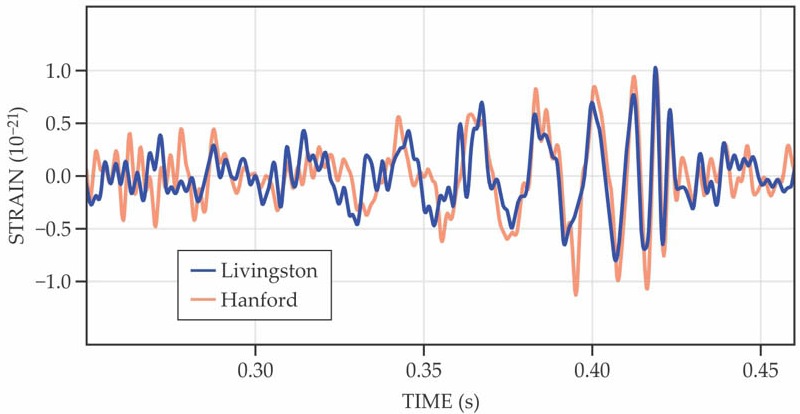
|
Then it happened. LIGO, which early September 2015 had a new Hannover laser system installed, was still having test runs. All signals were in real time also transmitted to Hannover. On 14 September 2015, a wave arrived first at Livingston, then just 7 milliseconds later at Hanford. In Hannover the signal was recognised as possibly a true wave. But is was well after midnight in the USA. One had to wait until the american partners had woken up. Soon it was clear, the signals from Hanford and Livingston were in concord!
The waves (the stretching and shrinking of space-time in the path of the laser light) show up as peaks and throughs in the graph (from Abbott+ 2016). The 7 msec difference in arrival time at the stations has been taken out. The wave peaks arrive at small intervals of about 0.02 seconds. Then the intervals become shorter and the wave peaks higher, after which all becomes quiet again. The whole event lasted less than a second.
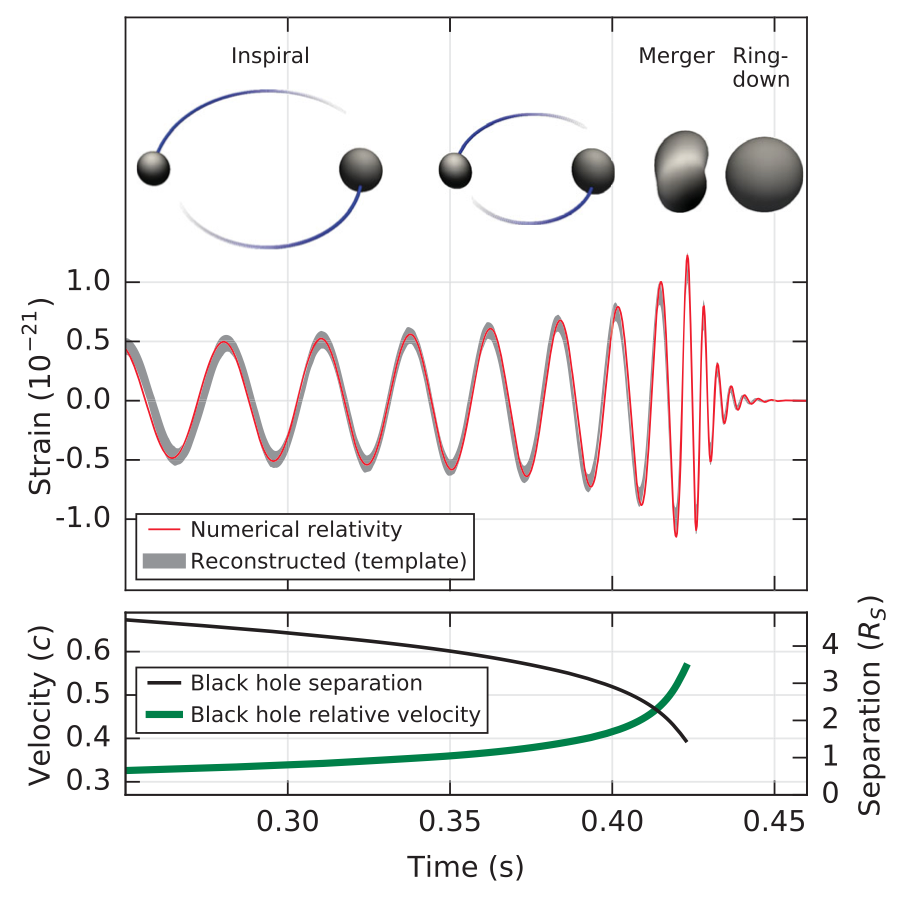
|
Modelling showed, that these gravitational waves came from the spiralling in of two black holes. The last figure shown here (from Abbott+ 2016) presents the modelled "clean" event so as to better recognize what has happened. These black holes each had a diameter of about 200 km and a mass of about 30 times that of the Sun, each moving just before merger with a velocity of about 1/2 of the speed of light. From the weakness of the signal it was deduced that the merging system was located at a distance of about a billion lightyears. The merger itself happened in just 1/10 of a second.
Three more gravitational wave events have been detected since then,
one of these by the new
VIRGO
station in Europe.
16 October 2017:
LIGO/VIRGO Merging neutron stars
The passage of a gravitational wave is a kind of "space quake", like " --ooonnmmMMMMM ".
The 2017 Nobel Prize in Physics has been awarded to LIGO's three longest standing leaders: Barry Barish and Kip Thorne of Caltech and Rainer Weiss of MIT.
References.
- Abbott, B.P. et al.
(LIGO Scientific Collaboration and Virgo Collaboration), 2016.
Phys. Rev. Lett. 116, 061102.
- de Boer, K.S., Seggewiss, W., 2008. "Stars and Stellar Evolution";
EdPSciences.
- Einstein, A., 1916. Sitzungsberichte der Königlich
Preussischen Akademie der Wiss. Berlin. part 1: 688–696.
- Marchant, P., Langer, N., et al., 2017. A&A 604, A55.
- Schwarzschild, K., 1916. Sitzungsberichte der Königlich
Preussischen Akademie der Wiss. Berlin; S.189ff.
- Wikipedia: https://en.wikipedia.org/wiki/Gravitational_wave
2017.10.08 nobel2017.html deboer@astro.uni-bonn.de